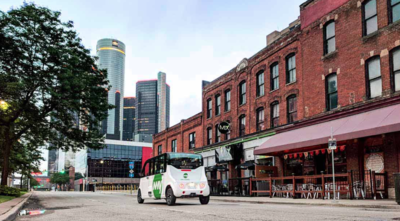Day 3 Management Briefing Seminar by Center for Automotive Research 2018
 Reflections On Autonomous Riding |
SEE ALSO: TACH Autonomous Vehicle Library - Opinion, News, Video, Images and 'Splaining
SEE ALSO: Autonomous Driving May Kill The Automobile Industry And Our Freedom Of Mobility
SEE ALSO: Why Driving Matters: Lutz, Hagerty, Carini Debate Future of Driving at Inaugural Hagerty Town Hall +VIDEO(1 Hour 11 Minutes)
By Thom Cannell
Senior Editor and Technology Lead
Michigan Bureau
The Auto Channel
Traverse City MI August 1, 2018; Today I chose to listen to presentations on, and about, Mobility, the concept that Real Soon, we’ll have Autonomous vehicles, on-demand Ride Sharing, a slew of Battery Electric Vehicles, as well as everything associated with this emerging technological juggernaut.
First, you must understand some key drivers. Air pollution in China is the primary driver, as well as similar problems in Europe and some US cities. Their solution is zero emissions vehicles—ZEVs—if you want to drive into London, Amsterdam, Los Angeles, or Beijing. Vast amounts of money are being spent (bet) on making these vehicles driverless, safe, and likely shared with many. What emerged during many presentations was a consensus that yes, it is coming, and soon. How quickly is the question, and we think electrification and autonomy will not arrive as soon as the pundits and experts expect. Which will, of itself, be disruptive.
Most automobile companies are spending millions, some billions, on developing mobility. Ford, Mercedes, BMW, Volvo, Nissan and most of the other names you’d know, as well as Chinese brands you don’t, are in a race to deliver self-driving vehicles. Which, some experts predict, will doom that very company. That whole discussion is a sidebar we’re not covering today.
Listening to experts from Nissan, Zipcar, May Mobility, Via, and Ridecell who spoke about everything from managing the safety of autonomous vehicles, to who will pick up the trash in a shared vehicle, we became more educated.
What surprised me most, after reading breathless expositions on how “Our Technology” will surmount the challenges of making the kinds of decisions you and I do every time we get behind the wheel, was Maartin Sierhaus’ explanation of Nissan’s approach. Maartin is director of Nissan’s research center in Silicon Valley, and an ex-NASA scientist. Using a series of out-the-front-window photos, he talked through the complexity that each intersection provides. “At a three-way stop, who goes first? What if things go wrong, if another driver breaks the rules?” he asked. Nissan’s focus is on “socially acceptable driving and human-like decision making”. Think about teaching a vehicle to drive, safely. Should it occasionally drive like a jerk? Oh, we learned that most autonomous vehicles require non-existent hyper-detailed maps of their driving area.
Maartin foresees a solution that offloads difficult decisions—like a utility truck blocking an entire lane, forcing an autonomous vehicle to break the law by crossing double-yellow lines—to a remote operator who then charts an acceptable path. Something you and I do instinctively. “Show me an autonomous system without humans in the loop and I’ll show you a useless system,” he pronounced.
Later in the day we listened to companies intimately involved with ride sharing, both public and private. Sabrina Sussman from Zipcar, the 18-year old “that will never work” ride sharing company pointed out how little you actually use your expensive vehicle—typically less than 10-percent of the day. That’s an expensive asset to lay idle. How about putting it to use, as General Motors is experimenting with in some cities, by renting your car? Sabrina says one Zipcar eliminates thirteen Personally Owned Vehicles, and that two-thirds of global population will live in cities by 2050. Where is the need for a POV, more to the point, where would you park?
If your city, like mine, has a bus transit system, likely you’ve noticed that giant buses are routinely nearly empty. What if the transit system had no defined route, no defined schedule, and was demand driven? That’s the proposition of Via, who operates on-demand shared rides in Washing DC, Chicago, Amsterdam, and New York. Yes, they can be seen to compete with services of Uber and Lyft. If you’ve been disabled, or had to use the bus system because your car was damaged, wouldn’t you like to have the local bus system come to your door? That, since 2013, is what Via, represented by Zac Wasserman, has done through public-private partnerships and flexible traditional public transit systems.
Here in Michigan, in Detroit, autonomous multi-person vehicles transport passengers from the Greektown food and entertainment neighborhood to the central business district, a crowded and congested area. May Mobility, with industry and NASA veterans in control, wants to deliver turnkey self-driving to truly interested partners. They’re doing it in Detroit.
May Mobility plans to roll out service in limited corridors, like the one in Detroit, with goal-oriented partners. Their plan is to develop micro-transit for large cities. According to co-founder Alisyn Malek, for now their vehicles have a ride-along “driver” to familiarize passengers with the need to buckle up, and answer questions.
Now we dive deeply into the complexity of the Autonomous, Electric, and On-demand future seen by many in the industry. Mark Thomas of Ridecell foresees such a future. He said that traditional automakers, globally and in total, represent just over $1 billion dollars, but by 2030 Mobility As A Service might be worth $9 billion. And he suggests that in 2030 two-thirds of all vehicles will be devoted to mobility.
What does that mean? Who will care for those appliances, and will the vehicle let you out until you’ve cleaned up your trash and taken your coffee cup with you?
Mark says traditional dealerships are poised to take advantage of sales and maintenance of mobility vehicles. Energy companies have the infrastructure to provide charging, and other services. Why does he see such a future? With real autonomy—and safety—a driverless car costs less (though are expected to cost around $50,000) and fuel cost is 10¢ less per gallon-equivalent. A potential victim is the rental car industry, who must adapt to renting by the minute, not the day.
Looming large are the necessary changes to vehicle codes (some states require mechanical connections to the brakes, for instance) and obtaining a national policy, not fractioned by individual states and cities, as is happening now. Autonomy is complex; few legislatures are equipped to deal with it. As in, will your self-driven car need a driver’s license?
Yet, it’s attractive to consider a future where all can snap a picture of themselves, a driver’s license, and a form of payment and go.
This extends mobility to old and young, able bodied and challenged persons, and makes no distinction upon wealth. But you still have to take your coffee cup with you before the vehicle will let you out, or so we hope.



